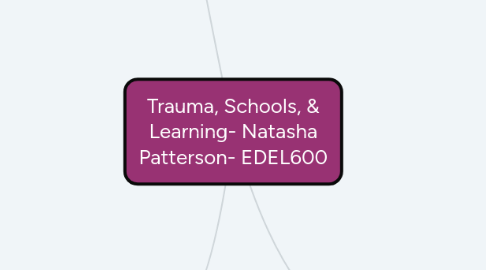
1. Trauma
1.1. Pandemic Trauma/ PTSD
1.1.1. Fear of death, panic lack of control, anxiety, fear of unknown
1.1.1.1. Collective emotions bring up past trauma
1.2. Vicarious Trauma
1.2.1. Teachers experience the trauma through hearing and living through pain with students
1.2.1.1. Known as "cost of caring"
1.3. ACES- Adverse Childhood Experiences
1.3.1. People need and want to feel safe
1.3.1.1. Examples of ACES
1.3.1.1.1. Neglect/abuse
1.3.1.1.2. Pandemic Isolation
1.3.1.1.3. Violence
1.3.1.1.4. Addiction
1.3.1.1.5. Loss of a Parent/Guardian
1.3.1.1.6. Homelessness
1.3.1.1.7. Poverty
1.3.1.1.8. Discrimination
2. Social Emotional Learning
2.1. School
2.1.1. Teacher's Role
2.1.1.1. Attend PD & become educated on the best researched-based practices
2.1.1.2. Provide expectations for students or work with students to develop class expectations
2.1.1.3. Encourage students to practice self-regulation and resilience
2.1.1.4. Teach students and provide opportunities for students to practice SEL skills
2.1.1.5. Provide quiet areas for students to calm down or de-escalate
2.1.1.6. Maintain and teach routines and transitions to help students feel safe
2.1.1.7. Provide a calm classroom environment
2.1.1.8. Be observant and seek opportunities to support students
2.1.1.9. Communicate with families and caregivers
2.1.1.10. Provide opportunities to build relationships with students
2.1.1.11. Give pre-assessments to determine areas of learning loss and areas of need
2.1.2. School Roles (Principals/Admin, Counselor, SEL Coach Roles)
2.1.2.1. Provide SEL curriculum and training for teachers
2.1.2.2. Provide additional professional development opportunities for teachers
2.1.2.3. Provide mental health supports for both teachers and students
2.1.2.4. Maintain consistency when addressing issues connected to trauma and stress
2.1.2.5. Communicate with families and caregivers when issues get addressed at the admin level
2.1.2.6. Provide opportunities to build relationships among the staff members, so they can go out and build relationships with students
2.1.2.7. Encourage the teachers and staff members to have a restorative restart the first six weeks of school
3. Coping Strategies
3.1. Ideas For Kids
3.1.1. Write in a journal
3.1.2. Spend time in a peace corner or regulation room
3.1.3. Getting appropriate amount of sleep each night
3.1.4. See a therapist or school counselor
3.1.5. Time to connect with peers through small groups and SEL conversations
3.1.6. Count to 5
3.1.7. Visualization strategies
3.2. Ideas For Teachers
3.2.1. Self care
3.2.1.1. Exercise
3.2.1.2. Yoga
3.2.1.3. Reading for pleasure
3.2.1.4. Consistent sleep schedule
3.2.1.5. Eat Healthy-Fruits & Veggies
3.2.2. Help others such as family and friends
3.2.3. Maintain consistent routines in and out of the classroom
3.2.4. Be willing to have flexibility
3.2.5. Take advantage of the relaxation station if your school offers that room
3.2.6. Limit watching the news
3.2.7. See a therapist/counselor
3.2.8. Map out the school day. Identify the most stressful times and build in coping strategies throughout the day
3.3. Brain Power
3.3.1. Neuroplasticity & New Neural Connections
3.3.1.1. The brain has its own way of coping. It can rewire itself in the right calm, safe environment.
